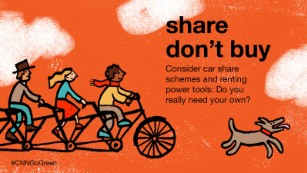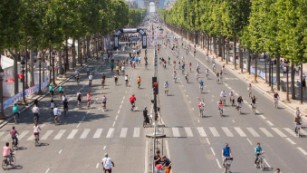Maubeuge, France – Four months and 1,300 miles ago, Erlend Moster Knudsen started running. Starting line: Arctic Norway. Destination: a U.N. climate change summit in Paris.
I met the aerobically inclined climate scientist on the road last week in northern France. He ran (he is on his fourth pair of shoes) while I biked behind him, struggling to keep up.
Freezing rain and snow pelted our faces as we traveled past misty fields, tile-roofed villages and Edward Scissorhands shrubbery. The whole thing was exhausting, but Knudsen, a 29-year-old with sandy hair, a scraggly beard and a Spandex-meets-DayGlo wardrobe, wasn’t fazed by any of it. He seemed to thrive on the Fargo-like conditions.
“I love the snow!” he said, darting up a hill.
These are difficult times, as I don’t need to remind you. ISIS is on everyone’s mind, especially here in France, where at least 130 people were killed in a recent terror attack. Fear cloaks this country like a persistent fog, and many observers worry that the threat of terror will infect the upcoming U.N. climate change summit, called COP21, which begins Monday in a Parisian suburb.
But spending a day with Knudsen gave me a healthy dose of optimism in addition to sore thighs. There’s ample reason to believe the U.N. talks will help shove the world off of fossil fuels and toward a cleaner future. All we have to do is what Knudsen recommends: Put one foot in front of the other, remember why we’re here, and carry with us an important collection of stories.
Another form of terror
Like Knudsen’s past several months, my year has been a prelude to the Paris summit.
But with, you know, less running.
I’ve spent most of 2015 taking your questions about climate change and turning them into stories as part ofCNN’s Two° series. If you’ve been reading along, you know that 2 degrees Celsius is the number at the center of the upcoming Paris negotiations.
Pretty much every country in the world has signed a treaty saying that 2 degrees Celsius of warming, measured since the Industrial Revolution, is all we can tolerate. Cross that line, and we’re expected to supercharge droughts, make storms more intense, commit low-lying islands to a watery death as seas rise, push millions more into poverty and put many plants and animals at risk of extinction. It’s not an exact trigger point (1.9 degrees of warming is monumentally less catastrophic than 2.1 degrees, for instance), but diplomats had to draw a line in the sand.
And everyone agrees that 2 degrees of warming is too much.
Yet we don’t act like it. We’ve already warmed the climate about 1 degree Celsius. We’re essentially locked into 1.5 degrees of warming based on all of the pollution we’ve pumped into the atmosphere, primarily by burning fossil fuels for heat and electricity. And pollution-reduction pledges logged by more than 140 countries in advance of the Paris talks promise to slow warming only to an estimated 2.7 degrees by the end of the century.
Signs of warming abound: 2015 promises to be the hottest year on record; a heat wave in India killed 2,300 people this summer; air pollution is killing far more people all the time; floods in the United States likely have been made worse by higher-than-normal tides; there’s evidence that a drought in Syria helped create conditions that led to the rise of ISIS.
We humans, however, are excellent at ignoring long-term global problems — like climate change. We focus on what’s right in front of us. The recent terror attacks are tragic, and many lives will never be the same because of them. They should not be minimized.
But climate change is another form of terror — and it’s one we’re wreaking on ourselves.
‘Worst-case scenario’
Being pessimistic about that is understandable, especially since previous attempts to use international politics to fix the climate problem largely have failed.
Before I spent a day with the running climate scientist, I spoke with Yvo de Boer, former head of the United Nations Framework Convention on Climate Change, the group that gets diplomats together to talk about the climate crisis. De Boer famously was moved to tears when a previous round of climate negotiations started to collapse.
“There’s a certain risk that political ambition trips over bureaucratic complexities,” he told me by phone. “There is this 50-odd-page document, which still contains many areas of disagreement. That stands between the beginning of the Paris conference and a successful outcome at the end. Very often at these conferences, the devil is in the detail.
“My worst-case scenario,” he continued, “is the one that we seem to see at almost every climate conference, which is that it needs to go into significant overtime.”
With 2 degrees on the horizon, there’s no time for delay.
Recently, there was much optimism ahead of the Paris climate talks. China and the United States, the world’s two biggest polluters, have pledged significant cuts in carbon pollution. The Obama administration rejected the Keystone XL pipeline, which was a symbolic boost for efforts to get the world off of dirty fuels like oil and coal. The Pope has been helping people finally see climate change as a moral crisis, one that will hit the world’s poor the hardest. And solar power is getting much cheaper.
But along came ISIS. Now, massive public demonstrations at COP21 have been canceled, and a malaise hangs over the entire process.
Knudsen, the running climate scientist, thought about abandoning his Pole to Paris journey because of the terror attacks on November 13. He canceled public events he’d planned in Brussels, and he knows that his arrival in Paris probably will be met with little fanfare. He’d imagined hundreds of people running with him into the French capital. Now he’s not sure whether his arrival, probably later this week, he told me, will be noticed by much of anybody (You can follow his progress on the Pole to Paris website, as well as the path of a colleague biking from New Zealand). When I met him in Maubeuge, France, on November 23, he gave a talk to a room of 50 chairs, all but six of them empty.
It’s clear the world’s attention was elsewhere.
‘Pole to Paris’
“Great weather!” Knudsen yelled back at me as we crested a snowy hill.
He did that kind of thing all day.
He someh ow found energy to grin constantly and cheer me on while I sweated through six layers of clothing, struggling to do once, on a bike, what he does daily on foot.
ow found energy to grin constantly and cheer me on while I sweated through six layers of clothing, struggling to do once, on a bike, what he does daily on foot.
He told me he’s always been drawn to extremely remote, cold places, which I guess makes sense for a Norwegian guy who studies the Arctic. His unyielding optimism could be annoying if it weren’t so genuine. It starts to become contagious. By the end of the day, I found myself happily swishing through puddles on the bike, trying to give back some encouragement to Knudsen and two friends — Zoé Favart, 25; and Oria Jamar de Bolsée, 24 — who were joining him on this part of his European expedition.
His sunny demeanor has a clear source. Each morning, before lacing up his shoes and putting on still-wet clothes from the day before, Knudsen asks himself two questions: “What’s the goal of the day?” And “Why am I doing this?”
The answer to the first question often is fairly obvious: Today I want to survive, give an interesting presentation or tolerate a pesky CNN crew.
The answer to the second is more interesting. It usually has something to do with the people Knudsen has met en route. Like Laila Inga, an indigenous woman in the Arctic who, he told me, is having trouble surviving as a reindeer herder because of changes in the climate.

The snow is melting and refreezing more often, he said, making it difficult for reindeer to nuzzle through the ice to reach the vegetation hiding below.
Knudsen feels a responsibility to carry Inga’s story to Paris.
I feel similarly obliged to be a vessel for stories from the front lines after visiting, on your behalf, places that will be destroyed by 2 degrees of warming (the Marshall Islands) as well as those helping us beat that goal (a reservation in Montana).
I hope someone in Paris is ready to listen.
As reported by CNN
